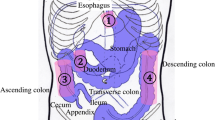Abstract
32 boys with symptoms of an acute scrotum had testicular sonography with color flow imaging (CFI). Patients ranged in age from 4–15 years (avg=11 yrs). Symptoms were present from 12 h to 5 days (avg=42 hrs). CFI correctly predicted presence or absence of testicular perfusion in 11 boys who had surgical exploration of the scrotum. 8 of these 11 patients had hemorrhagic infarction of the testicle, 1 had torsion of the appendix epididymis, 1 had epididymitis, and 1 had bilateral incomplete torsions with normal testicular perfusion. The remaining 21 patients did not have an operation. At least a 1 year followup of all patients has shown no clinical evidence of testicular atrophy to suggest a misse diagnosis of torsion. Absence or markedly decreased testicular flow was easily identified and indicates testicular ischema/infarction. Conversely, hyperemia of the testis and/or epididymis is usually associated with trauma or infection. However, incomplete torsion or spontaneous detorsion may demonstrate normal testicular flow on CFI. Only close correlation of clinical symptomatology and gray scale findings with CFI can identify these patients, who remain at high risk for subsequent complete torsion and infarction.
Similar content being viewed by others
References
Scorer CG, Farrington GH (1971) Torsion of the testis. In: Congenital deformities of the testis and epididymis, 1st edn. Butterworths, London 118–135
Donohue RE, Utley WLF (1978) Torsion of spermatic cord. Urology 11: 33–36
Trambert MA, Mattrey RF, Levine D, Berthoty DP (1990) Subacute scrotal pain: evaluation of torsion versus epididymitis with MR imaging. Radiology 175: 53–56
Marshall WA, Tanner JM (1970) Variations in the pattern of pubertal changes in boys. Arch Dis Child 45: 13–23
Zerin JM, DiPietro MA, Grignon A, Shea D (1990) Testicular infarction in the newborn: ultrasound findings. Pediatr Radiol 20: 329–330
Bird K, Rosenfield AT (1984) Testicular infarction secondary to acute inflammatory disease: demonstration by B-scan ultrasound. Radiology 152: 785–788
Mueller DL, Amundson GM, Rubin SZ, Wesenberg RL (1988) Acute scrotal abnormalities in children: diagnosis by combined sonography and scintigraphy. AJR 150: 643–646
Middleton WD, Melson GL (1989) Testicular ischemia: color Doppler sonographic findings in five patients. AJR 152: 1237–1239
Burks DD, Markey BJ, Burkhard TK, Balsara ZN, Haluszka MM, Canning DA (1990) Suspected testicular torsion and ischemia: evaluation with color Doppler sonography. Radiology 175: 815–821
Lerner RM, Mevorach RA, Hulbert WC, Rabinowitz R (1990) Color Doppler US in the evaluation of acute scrotal disease. Radiology 176: 355–358
Middleton WD, Siegel BA, Melson GL, Yates CK, Andriole GL (1990) Acute scrotal disorders: prospective comparison of color Doppler US and testicular scintigraphy. Radiology 177: 177–181
Stedman's Medical Dictionary (1972) 23rd edn. Williams & Wilkins, Baltimore
Hadziselimovic F, Kogan SJ (1987) Testes and scrotum. In: Gullenwarer JY, Grayhack JT, Howard SS, Duckett JR (eds) Adult and pediatric urology. Year Book Medical, Chicago pp 1932–2000
Parker RM, Robison JR (1971) Anatomy and diagnosis of torsion of the testicle. J Urol 106: 243–247
Taylor KJW, Holland S (1990) Doppler US: Part I. Basic principles, instrumentation, and pitfalls. Radiology 174: 297–307
Nelson TR, Pretorius DH (1988) The Doppler signal: where does it come from and what does it mean? AJR 151: 439–447
Author information
Authors and Affiliations
Rights and permissions
About this article
Cite this article
Meza, M.P., Amundson, G.M., Aquilina, J.W. et al. Color flow imaging in children with clinically suspected testicular torsion. Pediatr Radiol 22, 370–373 (1992). https://doi.org/10.1007/BF02016260
Received:
Accepted:
Issue Date:
DOI: https://doi.org/10.1007/BF02016260




